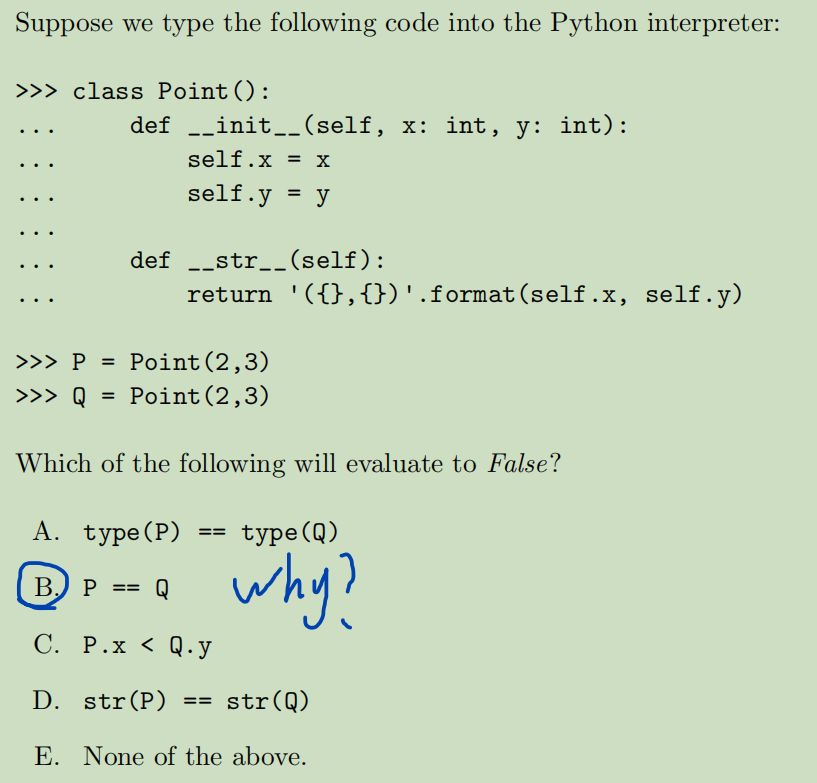Can someone help me to explain this? This is a past time question. The answer is (B), which is P == Q will evaluate as False, but I don't understand why. Question: Suppose we type the following code into the Python interpreter: >>> class Point(): ... def __init__(self, x: int, y: int): ... self.x = x ... self.y = y ... ... def __str__(self): ... return '({},{})'.format(self.x, self.y) >>> P = Point(2,3) >>> Q = Point(2,3) Which of the following will evaluate to False? A. type(P) == type(Q) B. P == Q C. P.x < Q.y D. str(P) ==
Can someone help me to explain this? This is a past time question. The answer is (B), which is P == Q will evaluate as False, but I don't understand why. Question: Suppose we type the following code into the Python interpreter: >>> class Point(): ... def __init__(self, x: int, y: int): ... self.x = x ... self.y = y ... ... def __str__(self): ... return '({},{})'.format(self.x, self.y) >>> P = Point(2,3) >>> Q = Point(2,3) Which of the following will evaluate to False? A. type(P) == type(Q) B. P == Q C. P.x < Q.y D. str(P) ==
Database System Concepts
7th Edition
ISBN:9780078022159
Author:Abraham Silberschatz Professor, Henry F. Korth, S. Sudarshan
Publisher:Abraham Silberschatz Professor, Henry F. Korth, S. Sudarshan
Chapter1: Introduction
Section: Chapter Questions
Problem 1PE
Related questions
Question
Can someone help me to explain this? This is a past time question. The answer is (B), which is P == Q will evaluate as False, but I don't understand why.
Question:
Suppose we type the following code into the Python interpreter:
>>> class Point():
... def __init__(self, x: int, y: int):
... self.x = x
... self.y = y
...
... def __str__(self):
... return '({},{})'.format(self.x, self.y)
>>> P = Point(2,3)
>>> Q = Point(2,3)
Which of the following will evaluate to False?
A. type(P) == type(Q)
B. P == Q
C. P.x < Q.y
D. str(P) == str(Q)
E. None of the above.

Transcribed Image Text:Suppose we type the following code into the Python interpreter:
>>> class Point ():
def
__init__(self, x: int, y: int):
self.x = x
self.y = y
def __str__(self):
=
>>> P = Point (2,3)
>>> Q
Point (2,3)
return '({},{})'.format(self.x, self.y)
Which of the following will evaluate to False?
A. type (P)
type (Q)
B. P
Q
why?
C. P.x < Q.y
D. str(P) == str(Q)
E. None of the above.
==
==
Expert Solution
This question has been solved!
Explore an expertly crafted, step-by-step solution for a thorough understanding of key concepts.
Step by step
Solved in 2 steps

Knowledge Booster
Learn more about
Need a deep-dive on the concept behind this application? Look no further. Learn more about this topic, computer-science and related others by exploring similar questions and additional content below.Recommended textbooks for you

Database System Concepts
Computer Science
ISBN:
9780078022159
Author:
Abraham Silberschatz Professor, Henry F. Korth, S. Sudarshan
Publisher:
McGraw-Hill Education

Starting Out with Python (4th Edition)
Computer Science
ISBN:
9780134444321
Author:
Tony Gaddis
Publisher:
PEARSON

Digital Fundamentals (11th Edition)
Computer Science
ISBN:
9780132737968
Author:
Thomas L. Floyd
Publisher:
PEARSON

Database System Concepts
Computer Science
ISBN:
9780078022159
Author:
Abraham Silberschatz Professor, Henry F. Korth, S. Sudarshan
Publisher:
McGraw-Hill Education

Starting Out with Python (4th Edition)
Computer Science
ISBN:
9780134444321
Author:
Tony Gaddis
Publisher:
PEARSON

Digital Fundamentals (11th Edition)
Computer Science
ISBN:
9780132737968
Author:
Thomas L. Floyd
Publisher:
PEARSON

C How to Program (8th Edition)
Computer Science
ISBN:
9780133976892
Author:
Paul J. Deitel, Harvey Deitel
Publisher:
PEARSON

Database Systems: Design, Implementation, & Manag…
Computer Science
ISBN:
9781337627900
Author:
Carlos Coronel, Steven Morris
Publisher:
Cengage Learning

Programmable Logic Controllers
Computer Science
ISBN:
9780073373843
Author:
Frank D. Petruzella
Publisher:
McGraw-Hill Education